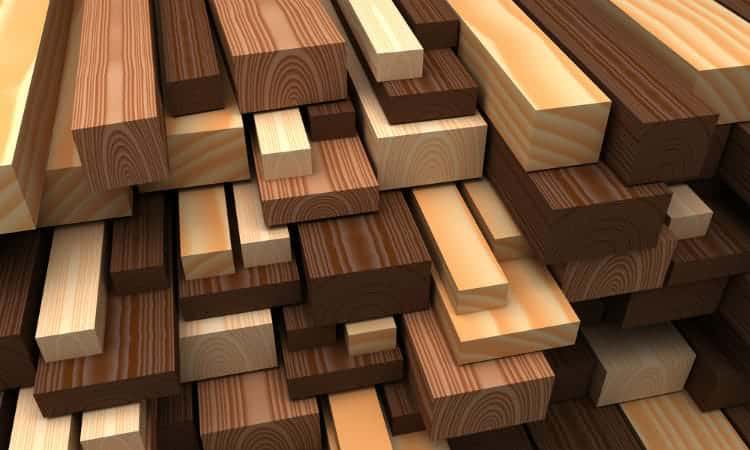Wood is known for its ability to absorb sound, making it a popular material for soundproofing and acoustic treatments. Its porous structure allows it to trap and dissipate sound waves, reducing echo and reverberation in a space. This makes wood an excellent choice for applications such as flooring, wall panels, and furniture in areas where noise control is important. Additionally, the dense nature of certain wood species, such as oak or walnut, enhances their sound-absorbing properties. Overall, wood’s natural characteristics make it an effective material for sound absorption.

Exploring the Sound Absorption Properties of Wood
Wood is a versatile material that has been used in construction and design for centuries. Apart from its aesthetic appeal and structural strength, wood also possesses unique properties that make it an excellent choice for sound absorption. In this section, we will delve into the fascinating world of sound absorption and explore how wood can effectively dampen and reduce noise.

1. The Science Behind Sound Absorption
Before we delve into the sound absorption properties of wood, it is essential to understand the science behind sound absorption. Sound waves travel through the air as vibrations, and when they encounter a material, such as wood, the energy of the sound wave is either reflected, transmitted, or absorbed.
Sound absorption occurs when the sound waves are converted into heat energy within the material. A material’s ability to absorb sound is measured by its sound absorption coefficient, which ranges from 0 (complete reflection) to 1 (complete absorption). Materials with a higher absorption coefficient are more effective at reducing noise.
2. Wood as a Sound Absorber
Wood exhibits excellent sound absorption properties due to its unique cellular structure. When sound waves interact with wood, they penetrate the material and encounter air pockets within the wood’s cellular structure. These air pockets act as resonators, absorbing and dissipating the sound energy.
Furthermore, the fibrous nature of wood allows for increased surface area, which enhances sound absorption. As sound waves travel through the wood fibers, they encounter myriad irregularities and obstructions, causing the sound energy to scatter and dissipate.
3. Factors Influencing Wood’s Sound Absorption
While wood, in general, possesses sound-absorbing properties, certain factors can influence its effectiveness. These factors include:
- Density: The density of wood has a significant impact on its sound absorption capabilities. Generally, softer and less dense woods, such as cedar or pine, exhibit better sound absorption than harder woods like oak or mahogany.
- Thickness: Thicker wood panels tend to be more effective at absorbing sound due to increased mass and the greater opportunity for sound wave interaction.
- Finish: The surface finish of wood can also affect its sound absorption properties. Rough or porous finishes, like unfinished wood or acoustic panels, tend to absorb sound better than smooth finishes.
- Grain Orientation: The orientation of the wood grain can impact its sound absorption capabilities. For instance, wood with a parallel grain orientation may exhibit different sound absorption characteristics compared to wood with a perpendicular grain orientation.
4. Applications of Wood Sound Absorption
The sound absorption properties of wood lend themselves well to various applications, including:
- Acoustic Panels: Wood panels can be specifically designed and treated to maximize sound absorption in auditoriums, recording studios, or any space where sound clarity is crucial.
- Soundproofing: By utilizing wood as a sound-absorbing material in walls, floors, and ceilings, it is possible to reduce the transmission of sound between different rooms or spaces.
- Furniture and Decor: Incorporating wood elements into furniture and decor items can help reduce ambient noise and create a more pleasant and acoustically balanced environment.
5. Conclusion
In summary, wood possesses remarkable sound absorption properties due to its cellular structure and fibrous nature. Factors such as density, thickness, finish, and grain orientation can influence its sound-absorbing capabilities. By leveraging wood’s sound absorption potential, we can create acoustically optimized spaces that enhance the overall auditory experience and improve the quality of our everyday lives.

The Science Behind Wood’s Sound Absorption Abilities
Wood is a widely used material in construction and design due to its various properties, including its natural beauty and durability. However, one lesser-known but significant attribute of wood is its sound absorption abilities. In this section, we will explore the science behind why wood is an effective material for absorbing sound.
When sound waves travel through the air, they can interact with different surfaces, including walls, floors, and ceilings. These surfaces can either reflect, transmit, or absorb sound waves. The ability of a material to absorb sound is usually measured using a metric known as the Sound Absorption Coefficient (SAC).
Wood has a relatively high SAC compared to many other building materials. This is primarily due to its porous nature. Wood consists of a complex cellular structure with tiny air pockets between its fibers. When sound waves encounter wood, they enter these air pockets and begin to dissipate.
The porous structure of wood acts as a natural sound absorber. As sound waves enter the wood, they travel through the air pockets and encounter numerous surfaces within the wood’s structure. These surfaces cause the sound waves to bounce around and lose energy, effectively reducing their intensity.
Additionally, the density and thickness of the wood also play a role in its sound absorption capabilities. Generally, thicker and denser wood materials tend to have higher SAC values. This is because thicker materials provide a greater barrier for sound waves, and denser materials have a higher number of fibers to interact with the waves.
Wood’s ability to absorb sound can be further enhanced through different treatment methods. For example, applying acoustic finishes or adding additional layers of sound-absorbing materials to wood surfaces can increase their sound absorption capabilities. These treatments can manipulate the surface properties of wood to enhance its ability to trap and dissipate sound waves.
One of the factors that contribute to wood’s sound absorption efficiency is the frequency of the sound waves. Different materials have varying degrees of sound absorption at different frequencies. Wood generally performs well in absorbing mid-range frequencies, which are commonly associated with human speech and music.
Furthermore, the natural properties of different wood species can also affect their sound absorption abilities. Some species have a tighter cellular structure with less air space, resulting in lower sound absorption. On the other hand, certain types of wood have a more porous structure, making them highly effective in absorbing sound.
In summary, wood’s sound absorption abilities can be attributed to its porous cellular structure, density, thickness, and surface treatments. Understanding the science behind wood’s sound absorption capabilities is essential in utilizing this material effectively in architectural and acoustic design, creating spaces with improved sound quality and reduced noise levels.

Enhancing Acoustic Performance with Wood Paneling
Wood paneling not only adds a touch of elegance and warmth to interior spaces but also offers a practical solution for enhancing acoustic performance. Whether it’s a commercial establishment, office space, or even a residential property, the right use of wood paneling can significantly improve the overall sound quality within a room. In this section, we will explore how wood paneling can contribute to better acoustics and create a more pleasant and functional environment.
1. Sound Absorption
One of the primary reasons why wood paneling is popular for enhancing acoustic performance is its sound absorption properties. When sound waves hit the surface of a wood panel, they tend to vibrate the wood fibers, which helps dissipate and absorb sound energy. The density and grain pattern of wood contribute to its ability to absorb sound, making it an effective material for reducing echo and noise reflections within a space.
Additionally, wood paneling can be further optimized for sound absorption by incorporating perforated or slotted designs. These designs create openings or cavities that allow sound waves to enter and get trapped, enhancing the absorption capabilities of the panels. By strategically placing these panels in areas prone to echo or reverberation, such as large open spaces or conference rooms, the overall sound quality of the room can be greatly improved.
2. Sound Insulation
Wood paneling also offers sound insulation benefits, which is particularly useful in environments where privacy and noise control are important. The dense nature of wood panels helps block and reduce the transmission of sound from one room to another, creating a more comfortable and peaceful atmosphere.
When installed as wall or ceiling panels, wood effectively acts as a barrier, preventing sound from passing through and minimizing external noises. This is especially beneficial in commercial spaces like restaurants, offices, or recording studios, where maintaining a quiet and focused environment is crucial for productivity and customer satisfaction.
3. Aesthetic Appeal
Aside from its functional advantages, wood paneling also adds a touch of elegance and natural beauty to any space. With a wide range of wood species, finishes, and designs available, it’s easy to find paneling that complements the overall interior design while enhancing the acoustic performance.
Wood paneling can be seamlessly integrated into various architectural styles, ranging from traditional to contemporary, creating a visually appealing and cohesive look. This versatility makes wood paneling a popular choice among architects, interior designers, and homeowners who value both aesthetics and functionality.
4. Sustainability
In addition to its acoustic benefits and aesthetic appeal, wood paneling is also a sustainable choice. Wood is a renewable resource and if sourced responsibly, it can contribute to reducing carbon emissions. By opting for wood paneling made from responsibly harvested or reclaimed wood, you can align your acoustic enhancement goals with environmental considerations.
Furthermore, wood paneling can also contribute to improved indoor air quality. Unlike synthetic materials that may emit harmful volatile organic compounds (VOCs), wood is a natural material that does not release harmful chemicals into the air, creating a healthier and more eco-friendly environment.
5. Installation and Maintenance
Installing wood paneling for acoustic purposes is a relatively straightforward process. Depending on the specific requirements and design preferences, the panels can be either fixed directly onto the walls or ceilings or used as floating panels with an air gap in between. Consultation with a professional installer is recommended to ensure proper placement and achieve optimal acoustic performance.
When it comes to maintenance, wood paneling is relatively easy to care for. Regular dusting and occasional cleaning with mild, non-abrasive cleaners are usually sufficient to keep the panels looking their best. Additionally, wood paneling can be refinished or repainted to suit changing styles or preferences, providing long-term versatility and durability.
Summary
Wood paneling offers a range of benefits when it comes to enhancing acoustic performance. Its sound absorption and insulation properties contribute to better sound quality and privacy, while the aesthetic appeal and sustainability make it a popular choice among designers and homeowners. The installation and maintenance of wood paneling are relatively straightforward, making it a practical and versatile solution for achieving both functional and visually pleasing spaces. Consider incorporating wood paneling into your interior design to create an environment that sounds as good as it looks.
Advantages and Limitations of Using Wood for Sound Absorption
Wood is a versatile material that has been used for various applications throughout history. One of its key properties is its ability to absorb sound. In this section, we will explore the advantages and limitations of using wood for sound absorption.
Advantages of Using Wood for Sound Absorption
- Natural Acoustic Properties: Wood has inherent acoustic properties that make it an excellent material for sound absorption. Its fibrous structure helps to dissipate and absorb sound energy, reducing echo and reverberation in a space.
- Environmental Sustainability: Wood is a renewable resource, making it a more sustainable choice compared to synthetic materials. Using wood for sound absorption can contribute to environmental conservation efforts.
- Aesthetic Appeal: Wood has a natural and warm aesthetic that adds visual appeal to any space. It can be used as a design element while also serving the functional purpose of sound absorption.
- Customizability: Wood can be easily shaped, carved, and treated to achieve desired sound absorption characteristics. It offers flexibility in design options, allowing for customization based on specific acoustic requirements.
- Durability: Wood is a durable material that can withstand wear and tear over time. Proper maintenance and treatment can further enhance its longevity, making it a cost-effective choice for long-term sound absorption solutions.
Limitations of Using Wood for Sound Absorption
- Frequency Range: Wood is more effective in absorbing mid to high-frequency sounds compared to low-frequency sounds. In spaces where low-frequency noise is a concern, additional sound-absorbing materials or techniques may be required.
- Moisture Sensitivity: Wood is sensitive to moisture and humidity. Excessive exposure to moisture can result in swelling, warping, or mold growth, compromising its sound absorption capabilities. Proper sealing and maintenance are necessary to mitigate moisture-related issues.
- Thickness Limitations: The thickness of wood panels can affect their sound absorption performance. Thicker panels tend to provide better absorption, but they may not be suitable for all applications due to space constraints.
- Fire Resistance: Wood is a combustible material and may not meet fire safety regulations in certain settings. Fire-resistant coatings or treatments can be applied to enhance its fire resistance, but careful consideration is needed in fire-prone environments.
- Cost: Depending on the type of wood and customization requirements, using wood for sound absorption can be more expensive compared to other materials. However, its durability and aesthetic value may justify the investment in the long run.
In summary, wood offers several advantages for sound absorption, including its natural acoustic properties, environmental sustainability, aesthetic appeal, customizability, and durability. However, it also has limitations in terms of frequency range, moisture sensitivity, thickness requirements, fire resistance, and cost. Considering these factors can help in determining whether wood is the right choice for a specific sound absorption application.
FAQs
Does wood absorb sound?
Yes, wood has natural sound-absorbing properties due to its porous nature. It can help reduce echo and reverberation in a room, making it a good choice for acoustic panels, flooring, and furniture.
Conclusion
In conclusion, wood does have the ability to absorb sound to some extent. Its dense and porous nature allows it to effectively reduce echoes and reverberations in a space. Wood is commonly used in construction and interior design to create acoustic properties and improve sound quality. When used as flooring, wall panels, or furniture, wood can help minimize noise transmission and create a more peaceful and pleasant environment. However, it is important to note that the degree of sound absorption varies depending on the type of wood and its thickness. To achieve optimal sound absorption, it may be necessary to combine wood with other acoustic materials and design techniques.